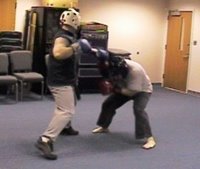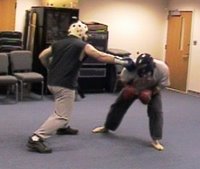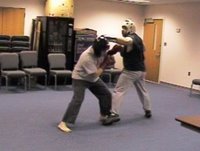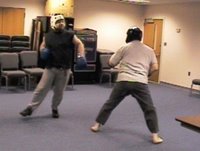The reason to slip is that it:
- Keeps you in range to counter
- The miss by the lead-off fighter will cause him to be momentarily off-balance. Conversely, if he leads and you block, you are still in his targeted area, and you haven't thrown off his balance. To test this statement, hold a shield or target for someone, then, without warning, move it and see what happens.
A slip to the inside is defined as moving your head and body to the side of the attacking arm with the inside of his elbow. For example, slipping to the inside of an orthodox fighter is to slip to your left. A slip to the outside is to go to the side of the arm where his elbow bends, or to the right of an orthodox fighter. Let's look at some examples, and why they may or may not be a good idea.
Slipping the lead to the Inside:
1. I lead off. Sam taks a step to his left

2. ... which is a mistake, because my power hand is my right, and I just have to complete my 1-2 combination

3. The combination is complete
Slipping the lead to the Outside:

1. Sam sees the lead coming and moves his head and body to his right, just outside of the punch

2. Even though I double up to try to catch him, he does a step-around move

3. Then he clears safely outside of punching range
ANALYSIS:
How would you make a slip to the inside work?
- Bob & weave to the left, so that your right shoulder is forward, and throw a counter at the same time
- Bob & weave to the left, so that your right shoulder is forward, and right hook to the body, or overhand over the extended lead arm
- Slip inside, close, and takedown/tackle
- Slip inside, close, and clinch
A more effective slip to the outside?
- Simultaneously jab with your lead hand to the head or body
- Use a check with your rear guard hand and step around so that your have flanked your opponent

No comments:
Post a Comment